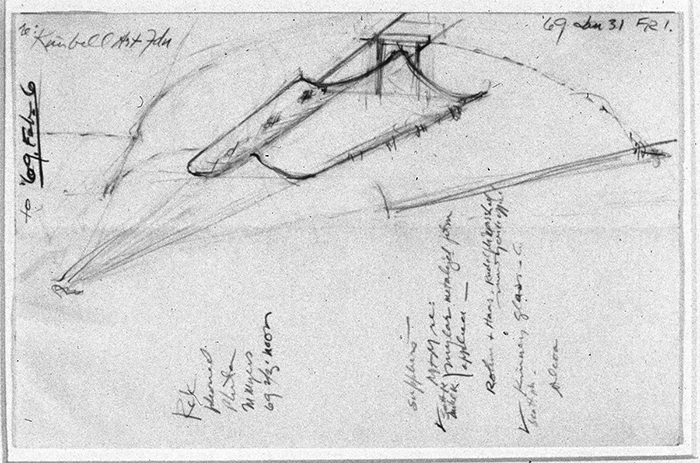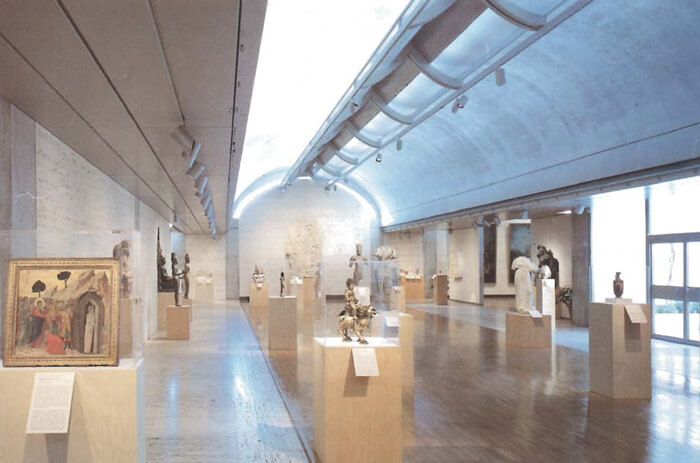THE KIMBELL ART MUSEUM
Fort Worth, Texas, 1972
Architect: Louis I. Kahn
In his late career, Richard Kelly consulted on two art museums in which daylight is the central theme – The Kimbell Art Museum in Fort Worth and the Yale Center for British Art in New Haven, Connecticut.
The masterful use of natural light found throughout these museums is the result of Kelly’s collaboration with architect Louis Kahn. The museums’ project architect Marshall Myers described the Kahn-Kelly association as a “perfect communion”. Kahn integrated natural light into the architectural structure of both museums. The conceptual approach that Kelly followed in illuminating their interior spaces articulated his belief that “the handling of forms, the meaning of a room, have to relate to daylight.”
The philosophy of the Kimbell Art Museum’s director called for a link between the changing quality of outside daylight with the observer’s experience of the art inside. However, the danger posed by direct sunlight and ultra violet rays to works of art on paper or fabric had to be addressed. Kahn envisioned a series of vaulted galleries with a north-south orientation at the apex of which ran a narrow slit to bring light into the interior. Light would be modulated by open courtyards, spaced in between the vaults, and crescent-shaped slits of glass placed in between the structural and non-structural parts of the vault. Together these daylighting elements give the museum the “luminosity of silver” and the viewer “the comfort of knowing the time of day”.

Preliminary sketch of daylight fixture.

Kimbell Art Museum
According to Kahn, Kelly’s involvement began early at “the inception of the idea of the shell, skylight and lighting fixture integration”. The scope of Kelly’s work extended to the overall illumination program which blended electric light with daylight. It included advising on ultraviolet filtration for the skylights and the nightlighting of the gardens and suggesting the planting of vines and foliage in the courtyards to filter light and to reduce its intensity as it flowed into the courtyards and building. The centerpiece of the lighting program is a winged reflector which runs along the peak of the cycloid vault and fills its underside with ambient light. Kelly provided the necessary breakthroughs for the two most important elements of the reflector’s design, its material and shape. At first Kelly thought Plexiglas was more practical than the one-way mirrored glass initially proposed by Kahn. Later Kelly suggested perforated aluminum because it offered both transparency and reflectivity. Moreover, it reduced the initial cost and required far less maintenance than acrylic. In February of 1969, Kelly drew a sweeping freehand curve that experience told him would produce maximum reflectance given the shape of the cycloid vault. A year later, Isaac Goodbar, an associate of Edison Price in New York City, ran a computer program that calculated the precise coordinates for the reflector curve and the intensity of light expected along the cycloid.
Budget considerations eliminated Kelly’s design for a small linear source of electrical light on the underside of the reflector which would have illuminated its surface at night; instead, track lighting was successfully integrated. The final design consists of a supporting yoke, a light track and a frame on which is attached a curved aluminum sheet. Perforations allow some daylight penetration to soften the contrast between the underside of the fixture and the adjacent daylighted concrete vault. The central portion of the sheeting that rises into the skylight was left unperforated to block direct sun. In areas safe to allow occasional sunlight – the lobby, bookstore, dining room, and library – a totally perforated reflector was used.
In the auditorium a motorized shutter system, designed by Kelly, allows the room to be darkened.
